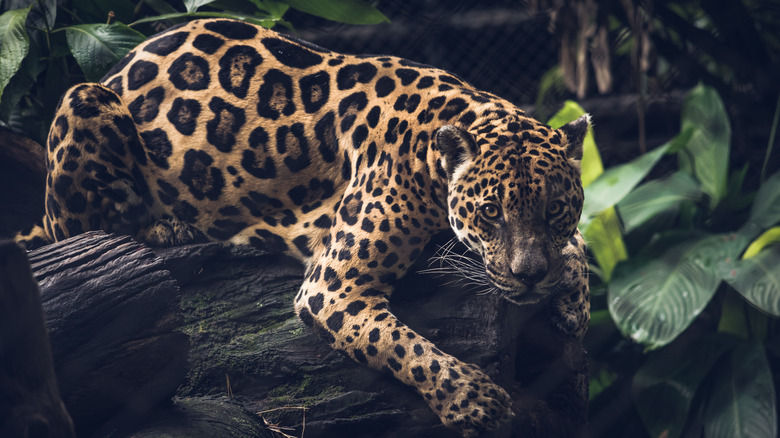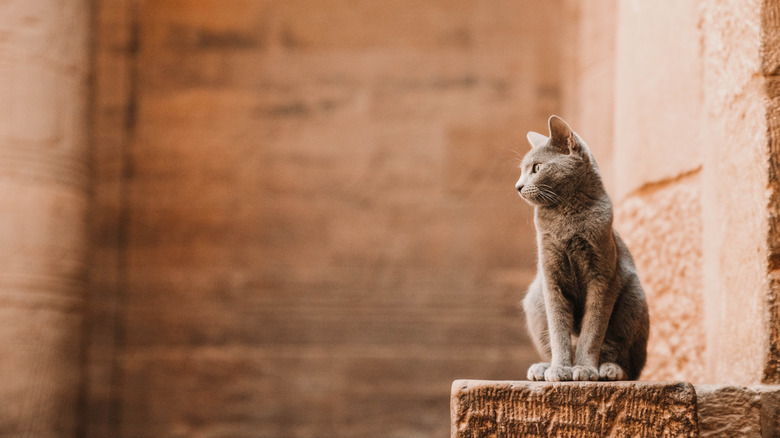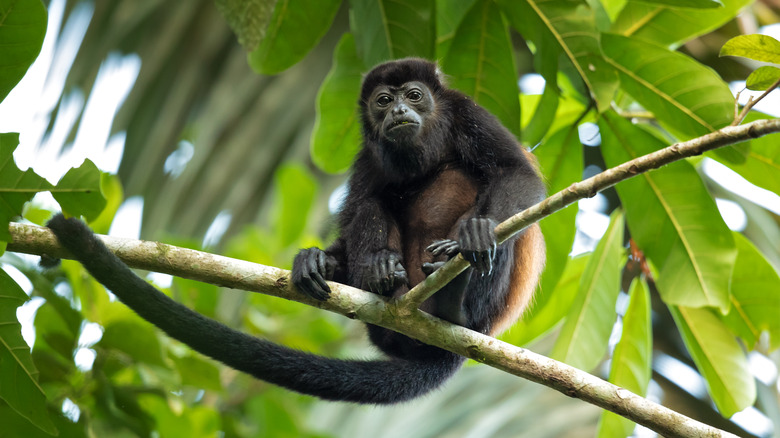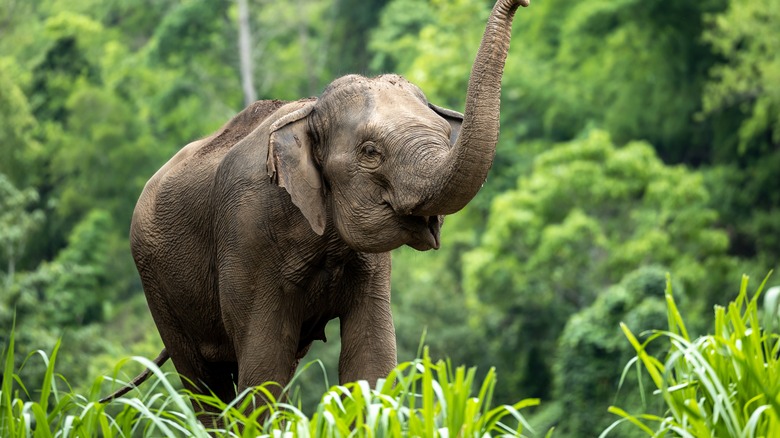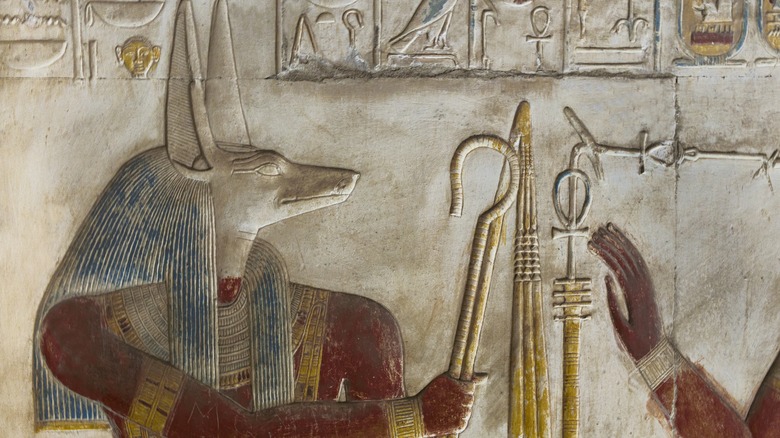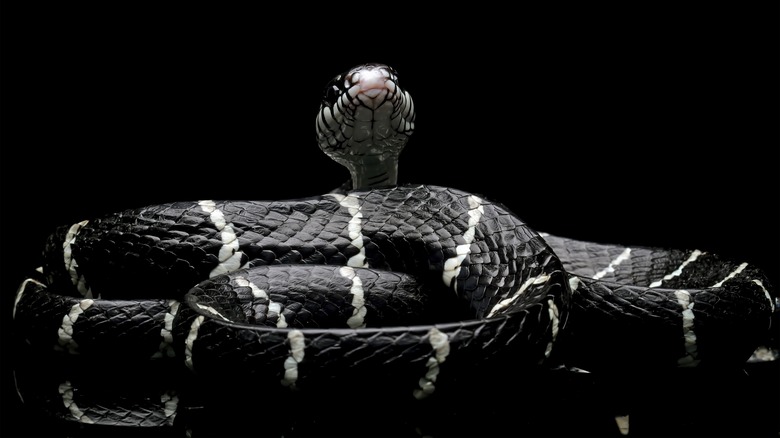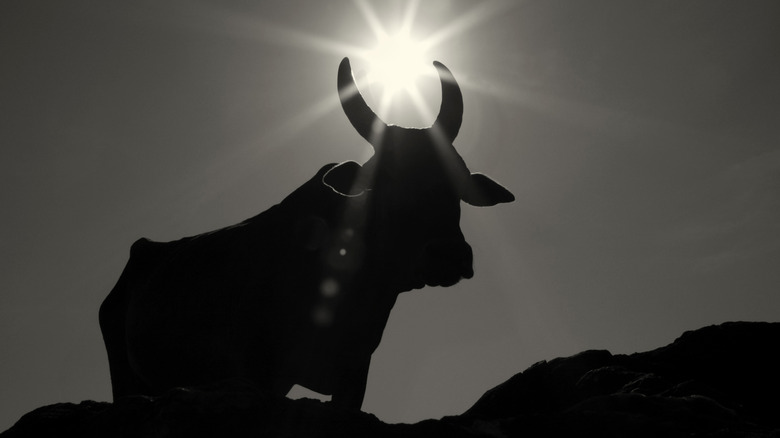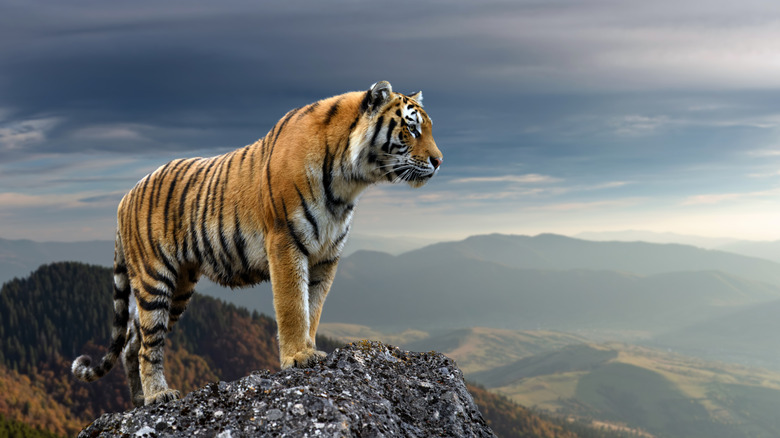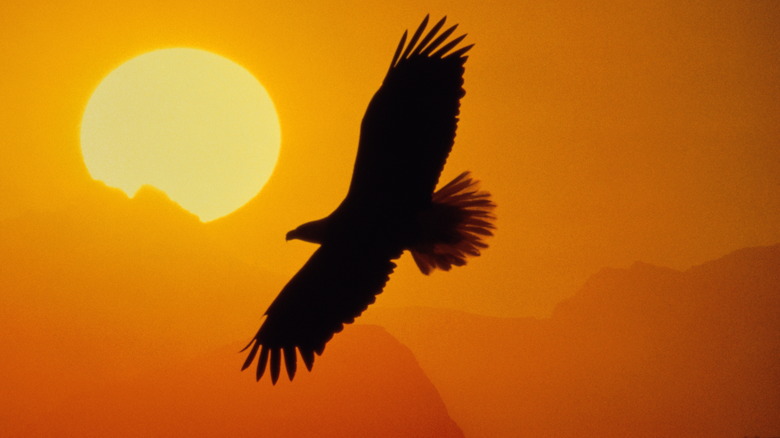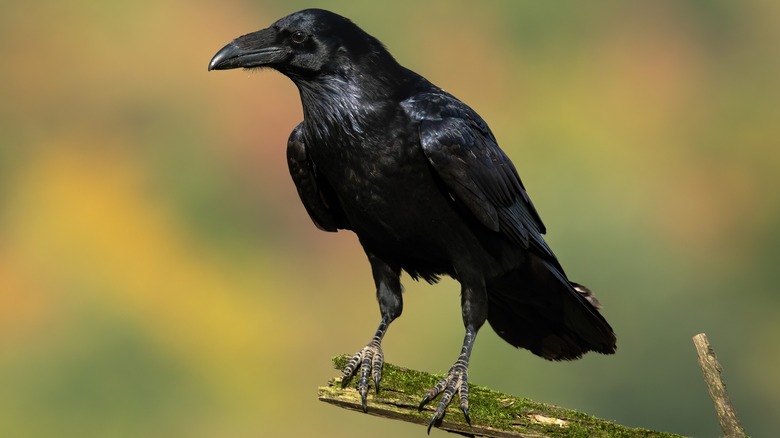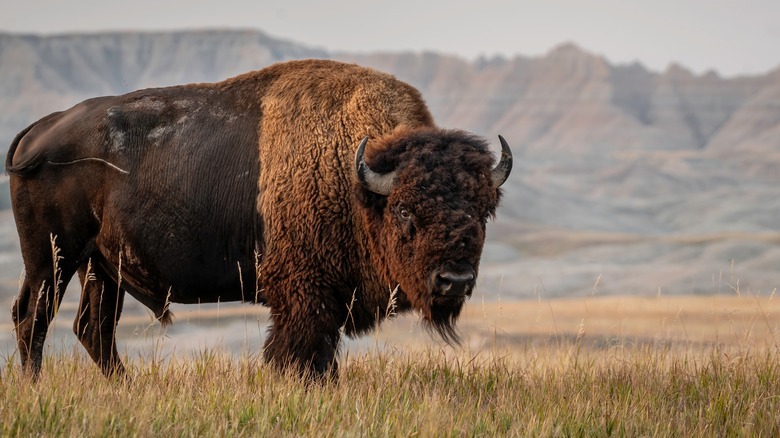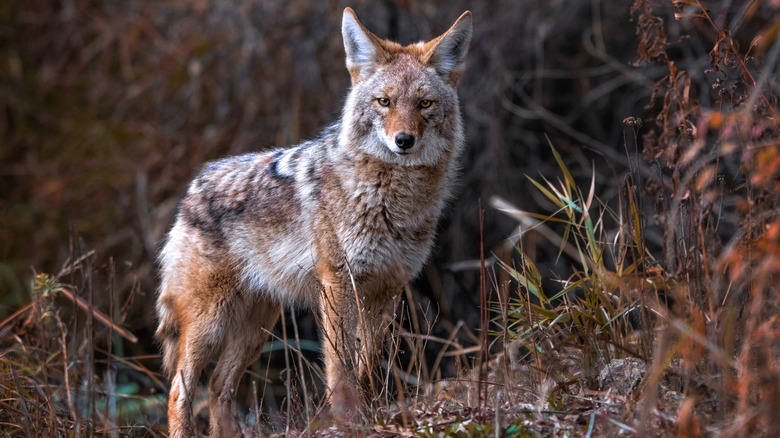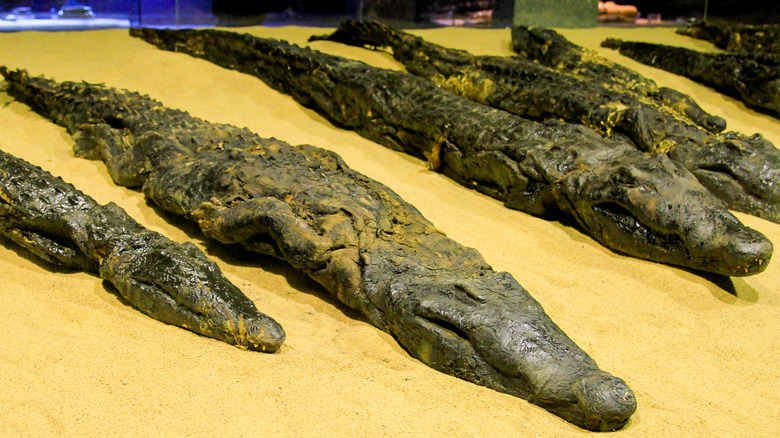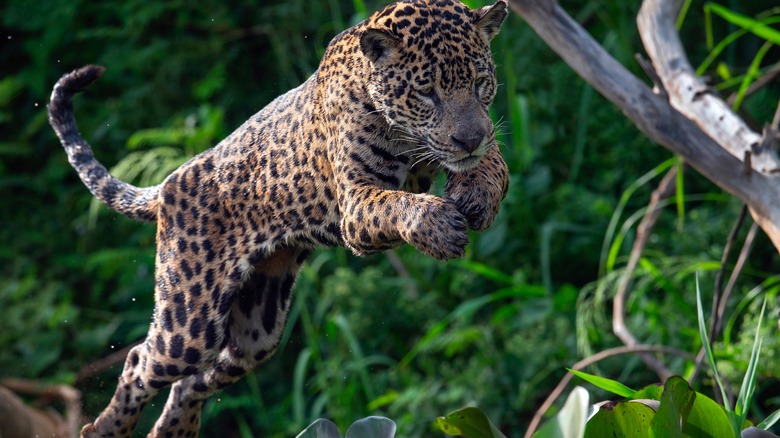Animals That Have Been Considered Sacred Throughout History
Since prehistoric times, animals have been endowed with godly attributes by tribes and civilizations. Animism – the belief that animals, wind, trees, water, and other earthly objects, harbor spiritual essences – was the dominant belief system for most of human history. Thus we find many animals that were and are considered sacred that play a role in folktales and legends (via The Open Encyclopedia of Anthropology). So integral were these animals to various cultures that most people can think of at least one example. Perhaps we think of the ancient Egyptians' fondness for cats or the reverence given to the buffalo by some indigenous North Americans.
As time went on, however, Westerners with monotheistic religions (the belief in a single god) conquered those who practiced animistic traditions. "Animal worship" was the pejorative term used for gods that took on animal form (via Britannica). Yet even Westerners sometimes perceived devilry in animals like monkeys and goats, or regarded some animals as closer to kin than others (via BBC). Let's explore the myriad roles animals play as sacred kin, tricksters, or gods of the afterlife.
Cats
The Ancient Egyptians are famous for having revered felines, holding them to the status of gods. The Egyptians kept cats in their homes and wanted to be with them in the afterlife as well. Their feline friends graced the walls of tombs and were sometimes mummified along with the deceased. But mummification wasn't meant to ensure a companion in the afterlife, but rather the cat was seen as a vessel the person could inhabit. They admired the cat's litheness and power, and this admiration manifested in the god Sekhmet – a goddess in lion form who served as a protector and warrior. Cats fulfilled this role in a practical sense as they deterred pests such as snakes and rodents. Therefore, killing cats wasn't allowed, given their god-like status, unless it was done for mummification (via History).
In modern times, cats also have a sacred status, and not just on the internet. In Islam, cats are considered holy and respected for their cleanliness. Traditionally, their status affords them the right to enter mosques and homes, and the Prophet Muhammad was said to be fond of felines, as was his companion Abu Hurairah – also called "Father of the Kittens" for his deep love for cats. Stories in Muslim communities even state that Muhammad refused to lift his sleeping cat, Muezza, from his prayer robe. He instead opted to slice off the sleeve so the beloved cat could slumber (per The Guardian).
Monkeys
Monkeys, with their human-like appearance, have a special place in many religions and folktales. In Buddhism, monkeys can be depicted negatively or positively. The 16th-century novel "Journey to the West" (via Encylopedia.com) follows a monk whose companion is the Monkey King and is endowed with supernatural powers and ultimately rewarded by the Buddha. Monkeys appear in Hinduism as well, and are revered by people in places like India and Bali, with the best-known representation being Hanuman, a monkey deity. Monkeys don't feature prominently in the Abrahamic religions, however, with Christians so opposed to pagan philosophy that they often held a disdain for monkeys and apes. The latter were especially disliked for the human-like appearance that made them seem devilish to some Christians (via Primates in World Religions).
But some indigenous cultures include our primate cousins in many tales and customs. One of the most interesting examples came from the Amazon, where the Guaja people considered monkeys as family. According to the book "Kinship with Monkeys," the Guaja felt close to many species, especially howler monkeys, and sometimes kept more monkeys in their homes than humans. Women would even raise motherless simians as children. But since the Guaja are animistic hunter-gatherers, they see killing animals for food or clothing as a form of necessary cannibalism. They even hunt their monkey kin while also respecting them as family.
Elephants
The elephant is an important part of Hinduism, which is most evident in the presence of Ganesha – the god with an elephant head. His name means "Lord of the People" and he's considered a god of the intellect. He has a pot belly and a large bandicoot rat as his transportation – which symbolizes his resolve to overcome challenges. Since intelligence and fecundity are his revered qualities, the summer Hindu festival of Ganesh Chaturthi is devoted to him, per Britannica. Thus the animal in the wild is also deified as the physical manifestation of Ganesha. With its trunk, it's believed to sniff out good or evil, with its sizable ears, it can hear, and with its beady eyes, it foresees the future and distinguishes truth from lies (via PBS).
Buddhists also consider elephants sacred, in particular the rare white elephant, which was revered in Thailand and part of the king's property. They had a place in war as well, since Asian elephants were ridden in battles (via PBS). In modern times, Southeast Asia has faced issues of deforestation, resulting in conflict between people and elephants. Elephants started entering more human territory as forests dwindled between 1880 and 2013, causing the animals to raid crops for food and become more aggressive — as did farmers who suffered economic losses. While they're still considered sacred in India, human expansion complicated their relationship with the admired beasts (per Sapiens).
Dogs
Dogs have held a special place as humankind's best companions, but they also held a religious role in some ancient cultures. In ancient Greece, the medicine god Asklepios had a canine by his side, a depiction later adopted by the Romans as the god Aesculapius. It's been said that the association of dogs with healing may have come from observations of them mending their wounds by licking, and the observation would translate to medical practice in the 4th century B.C.E, when the Greeks built a medical sanctuary in the city of Epidaurus where the sick went to receive medicinal licks from dogs. A center in Roman Britain served a similar purpose. At the time, they celebrated the Celtic god Nodons, who has been associated with dogs. At Lydney in Gloucestershire, offerings of dog figurines were left by the sick hoping for divine intervention, according to Amgueddfa Cymru.
Unlike the Greeks and Romans, the ancient Egyptians associated dogs with mortuary practices. The god Anubis took the partial form of a jackal, a canine depicted in tomb art and mortuary objects. As the god of death, Anubis presided over the journey of the deceased and protected gravesites. It is believed the association of jackals with death came from sightings of the animal prowling cemeteries to consume human remains (via Rosicrucian Egyptian Museum).
Snakes
Some of the oldest evidence for ritual snakes dates back 70,000 years ago in Botswana. In 2006, stones in the form of snakes were uncovered in a cave, suggesting early religious significance to the serpent (via Scientific American). Flash forward to the ancient Greeks, and snakes held a place as guardians in their mythology. They were considered the offspring of Gaia (Mother Earth) and the beings that were connected to the Earth as they slithered across its terrain. Although the mythology surrounding snakes also includes their venomous side, anthropologists say that the guardian snake derives from ancient times, when harmless snakes would slither into homes to stay warm by the hearths, thus inspiring a religious reverence from those who encountered them (via "The Meaning of the Snake in the Ancient Greek World").
In modern America, rituals involving snakes in the Appalachian region rest on the belief that the Christian god will protect believers from the venom (per National Geographic). Although Christianity sees malevolence in snakes, more animistic traditions regard them with more nuance. Quetzalcoatl, the feathered rattlesnake god of the Aztecs, was neither good nor evil but was instead a symbol of both death and regeneration (via Britannica). In Hopi culture, the Snake Dance was an important ritual at the end of August where snakes were instrumental in the welcoming of the season (via Britannica).
Cows
While cows are famously sacred in India, they've been involved in spiritual practices since prehistoric times. Over 30,000 years ago, the caves of Spain and France housed images of aurochs (the ancestors of modern cattle), suggesting that the animal held importance to the hunter-gatherers of those regions. With the rise of agriculture, cattle arguably bore an even greater significance, as indicated by the bull of Crete, which was important to the Greeks and Minoans (via the Alberta Government). Ancient Egypt also figured into the history of sacred cattle, with the Apis Bull being worshiped in the Early Dynastic Period (per University College London). Celtic mythology wasn't free from bull references either, as the tale "Cattle Raid of Cooley” depicted a war in Ireland over the Brown Bull – a magnificent animal with magical qualities (via the Alberta Government).
In Hinduism, the cow is divine and is given protection from harm. In ancient India, cows were part of their religion, although they were treated differently from what is seen today. In the 2nd to 7th millennium B.C.E, pastoralists who inhabited the region appreciated the importance of cattle for survival, and they were both ritually sacrificed and eaten. Over time, however, cows that produced milk were kept from harm. In the Hindu religious text, Mahabharata, and the code of ethics, Manusmṛiti, the slaughter of the revered bovid is forbidden (per Britannica).
Tigers
Hindus have a special affinity for tigers that roam the dense forests of India. The prime feline deity in the religion is Baghdev, also called Waghoba, which means "tiger god." Going back many centuries, indigenous people of Western and Central India deified leopards and tigers and it even persists in modern times (via Atlas Obscura). Some would argue that this creates more tolerance for the majestic animals. Indeed, according to a 2016 ethnographic study entitled, "Tigers Are Our Brothers," the Mishmi people on the border of India are noted for their strictures against hunting tigers.
Their revered status is somewhat at odds with the threat tigers create to villagers. In the Sundarbans, a mangrove forest on the border of India and Bangladesh, people face attacks by tigers on a not-too-infrequent basis. The Muslim and Hindu residents traverse in unison through the forests to collect wood and honey, believing increased numbers minimize the threat of attack. The goddess Bobbibi is said to be a protector who keeps the tigers at bay (per BBC). Even in the face of these problems, killing the animals is considered a last resort for some, as the tiger, even as it faces endangerment, enjoys some religious protections in Southeast Asia (via "Tigers Are Our Brothers").
Eagles
In America, eagles are a patriotic symbol, but other cultures have also been awed by the winged creature. For some Native American tribes, the eagle holds significance as a symbol of bravery and strength. Their feathers are considered an honor to wear, and since eagles are also a symbol of The Great Spirit, the feathers are used to adorn the sacred pipe (via St. Joseph's Indian School). In ancient times, cultures revered eagles as sacred, with the Greeks using them as the emblem of Zeus. They were given a similar god-like status by the Druids as well. In Roman mythology, the eagle was Jupiter's messenger, and when a new emperor was ordained, an eagle was sent flying away as a symbol of Jupiter's power. By doing this, they believed the bird would ensure the emperor's rank among the gods by carrying his spirit to heaven (via Johns Hopkins Archaeological Museum).
The association of eagles with strength is a common thread among different cultures. The Aztecs believed the eagle god represented the sky and sunlight and gave power to warriors. In Persia (modern Iran), the eagle symbolized the Persians' defeat of the Medes. Some comparisons have been drawn between the perception of lions and eagles, as one occupies the Earth while the other reigns in the sky with similar majesty and strength (via New Acropolis International Organization).
Ravens
In Edgar Allen Poe's dark poem "The Raven," the bird received a reputation for bringing bad omens, but this isn't a universal perception. Scandinavian people have a positive view of the ebony bird, and this is evinced by the first flag of Denmark in the 11th century, which featured a proud raven. Indeed, in Viking Norse tales, Odin is aided by shrewd ravens named Muninn and Huginn, one symbolizing memory and the other thought. In recent times, a 1967 law in Denmark prohibited the hunting of ravens, which some attribute to the reverence afforded them in mythology (via Audubon).
Other cultures had a range of interpretations, however, with Japan associating the bird with familial affection, and a similar interpretation existed in China. Going back to ancient Greece, the god Apollo considered the raven sacred and the Gauls shared this veneration (via New Acropolis International Organization). Sometimes ravens were depicted as tricksters, however. This was true of the indigenous Haida people of Canada, whose stories showed the raven creating order in the universe, only to initiate chaos later on (via Canadian Museum of History).
Buffalo
For some Native American peoples, the buffalo provided sustenance, shelter, clothing, and tools. From the bones, they crafted tools, while the hide was fashioned into clothing, and they even made soap out of the animal's fat. Rituals surrounding the buffalo were meant to display reverence for an animal that they considered as honorable as their own relatives. For early colonists, the buffalo was also a symbol, but mainly of conquering the land and its inhabitants. Columbus Delano, secretary of the interior in 1873, said (via the National Museum of the American Indian), "I would not seriously regret the total disappearance of the buffalo from our western plains, in its effect upon the Indians."
But while the European conquest altered the history of the buffalo forever, there is no denying that the animal was and is sacred to many Native Americans. Plains Indians believed that the buffalo nested within the earth until it emerged in the spring, with this belief, they felt it was important to invoke spiritual practices so The Great Spirit wouldn't withhold the gift of the animal (via Smithsonian Magazine). To this day, the buffalo is still respected, and the rare white buffalo is especially sacred as it signifies the beginning of life's spiritual loop (per the National Park Service).
Coyotes
The coyote has a range of purposes in the mythology of North American Indians. It appears as a magician, trickster, lover, and creator and is depicted as the animal that existed before humans walked the earth. In many tales, Coyote was the animal that procured sunlight and fire for humans and invented the arts, yet he was also portrayed as lacking social boundaries and thus catalyzed chaotic situations (via Britannica). The situations he instigated were meant to be didactic and caution young people against breaking social norms. The stories involving Coyote were widespread and told among many cultures, including the Navajo, Blackfoot, Shoshone, and Ute (per Hofstra University).
For the Nez Perce, Coyote figured prominently in their mythology, with the creation story revolving around Coyote as (via "Myths of the Nez Perce") "the chief of animals." But while he appeared authoritative and god-like in the creation stories, he was equally prone to being a buffoon who had sidekicks like Fox as his partner in crime. The tales have lasted through the centuries, and this important animal is still conceived as a flawed hero who brings adventure to the hundreds of myths in which he appears (per Okanagan College).
Crocodiles
The ancient Egyptian veneration for animals was expansive, and this was evident with their part animal gods, including Sebek – the crocodile god who lived in the province of Fayyūm. It isn't known for certain what Sebek's role originally was in Egyptian culture. According to Britannica, he may have been a god of death and burial or, perhaps, a fertility god. But later on, his identity was combined with Re, the sun god, and he became Sebek-Re. The Egyptians' reverence for crocodiles, which lasted until the Roman period, was evident in their mummification practices, as crocodiles preserved in time have been uncovered at Fayyūm and elsewhere in Egypt.
But crocodiles were also a totem for cultures elsewhere in Africa. In the Bechuana-Basuto region of South Africa, it was a crime to kill a crocodile, even by accident, and the deliberate act could result in execution. In the Basuto culture, a supernatural crocodile called Lafitwe could kill people with a glance or drag their shadows into the river where they'd drown. In a former province of South Africa, Transvaal, the Bapedi tribe believed their bodies held healing properties and used the brains of crocodiles as medicine (via South African Journal of Science).
For the ancient Maya, crocodiles played a role in their religious life since they appear in their myths and art. Some evidence even states that the ceremonial site of Nixtun-Chich' in Guatemala may have been designed to mimic the back of the reptile (via Journal of Archaeological Method and Theory).
Jaguars
In ancient Mesoamerica, the jaguar god Panthera Onca was worshiped. The predatory feline was considered divine by cultures like the Olmec, the Maya, and the Aztecs. In the art and architecture of these civilizations, it is evident that the jaguar was aligned with military prowess. One of the most prominent examples is the throne of El Castillo – Chichen Itza's great pyramid – which is adorned with the image of a red jaguar. In many depictions, there were half-jaguar, half-human beings, thus symbolizing the man with the jaguar's might. Fertility and the earth were also tied to the beast, as seen in the Aztec goddess Tlaltecuhtli, whose claws were those of the feline predator (via National Geographic).
The jaguar's role in society was complex. It was connected to the sky and earth, and to light and dark. This multidimensional role gave it a power that was transferred to Mesoamerican rulers. They were so respected that kings and warriors even added the jaguar to their names, and kings in Mayan culture adorned themselves with jaguar skins, per National Geographic.
Although the jaguar doesn't hold the same status in modern times, the animal is still celebrated by people in Guerrero, Mexico, who dress up as jaguars and partake in festivals. Although the feline is threatened by population decline and habitat loss, plenty of people in Mexico and Central America still admire the cat of ancient lore (via National Geographic).
